Bus Drivers & Transportation
Subcategories
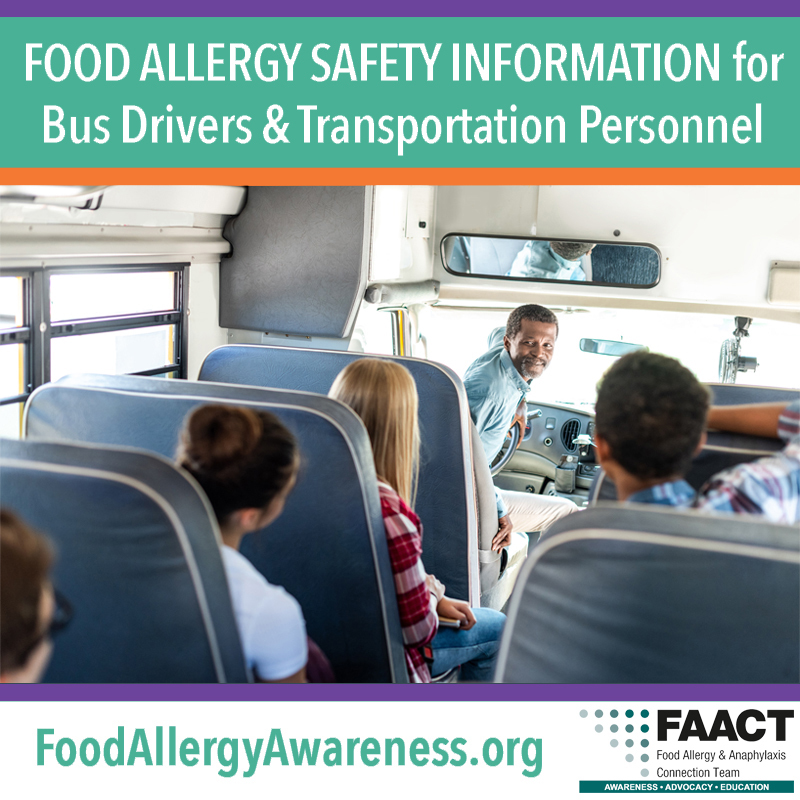
Bus Drivers and Transportation Personnel
Food allergy is a growing safety and public health concern in the United States. Schools and transportation staff continue to face challenges each year due to the increasing number of students with food allergies. Bus drivers and transportation personnel are an important part of food allergy management plans and may have specific responsibilities under a student’s accommodation plan.
When school staff, physicians, parents, and other adults who interact with students join forces, it helps to create comprehensive management plans for students. Thorough details and guidance outlined in management plans will help to support the efforts of all those involved in caring for food-allergic students and will help make the school setting a safer environment.
FAACTs
- There is no cure for food allergies. Strict avoidance of the food(s) is the only way to prevent a food allergy reaction from occurring.
- Every food allergy reaction has the possibility of developing into a life-threatening and potentially fatal allergic reaction.
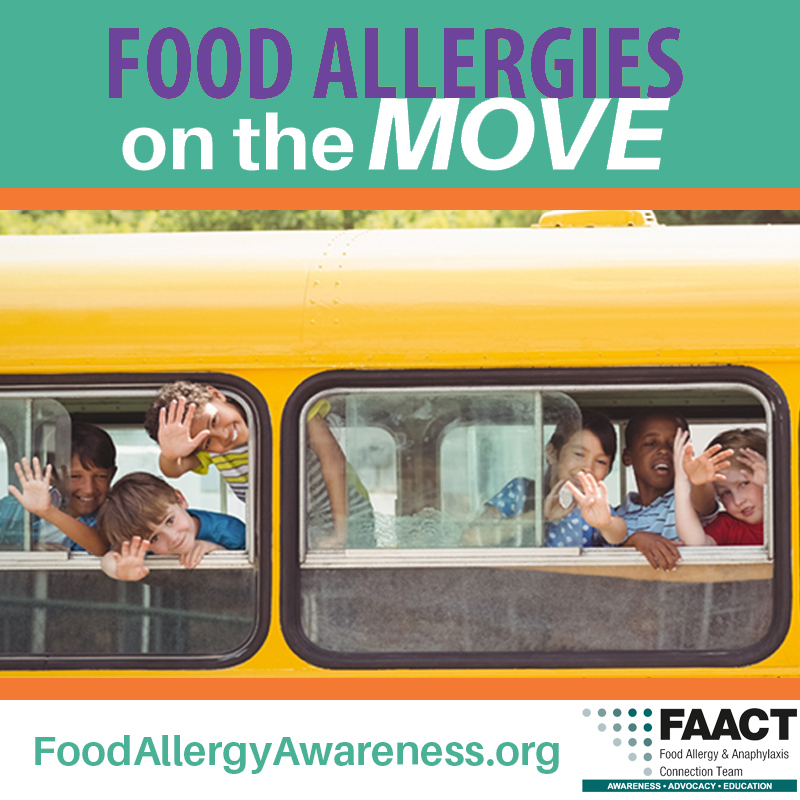
Food Allergies on the Move
Students with food allergies can be particularly vulnerable on the bus traveling to and from school. Staff who are familiar with a student’s medical needs are absent. Due to the lack of direct adult supervision, students may be at a greater risk for exposure to food allergens, either intentionally or accidentally; bullying; and other factors that present a risk.
So it is important for school personnel, or other designated representative, to inform bus drivers and other transportation staff about students’ allergies and train transportation staff how to identify and respond to a student who may experience anaphylaxis. This pertains to students who have a known allergy as well as students who may experience anaphylaxis for the first time without a history of allergic reactions.
FAACTs
- In approximately 25 percent of epinephrine administration cases involving students and staff members, school personnel were not aware that the individual had a life-threatening allergy.2
- Approximately 20 percent of cases requiring epinephrine administration in the school setting occurred outside the school building on the playground, traveling to and from the school, or on field trips.2
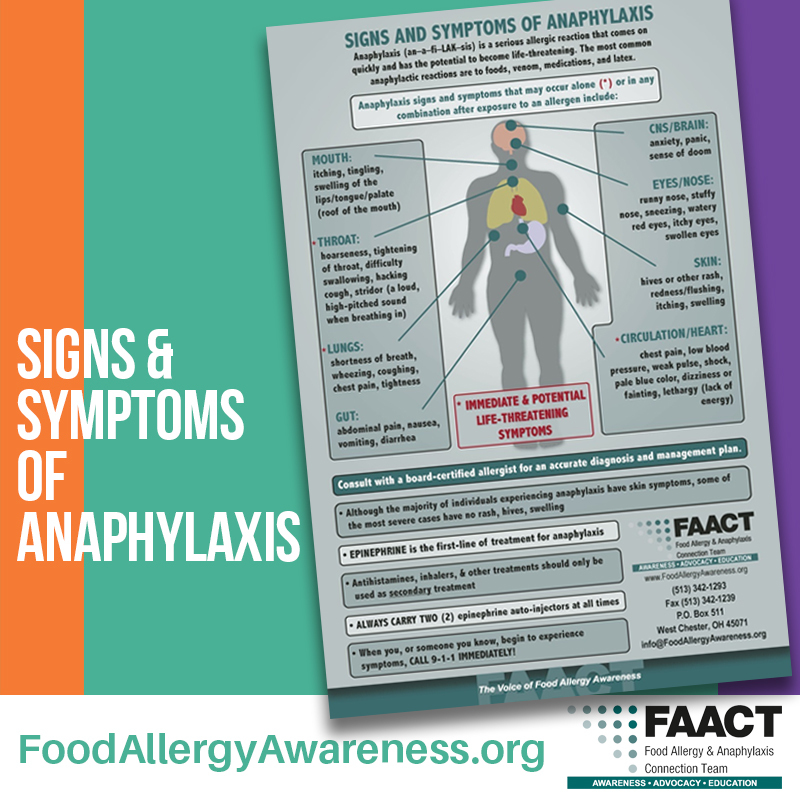
Signs & Symptoms
Signs and symptoms of an allergic reaction usually appear within a few minutes to several hours after exposure to a food allergen. If not treated promptly, food allergy reactions can be fatal. The student can also experience a second phase of their reaction called a biphasic reaction. This means the student may respond initially to treatment but experience symptoms later that are less severe, as severe, or even more severe than the initial reaction. After the administration of epinephrine, 9-1-1 should be called and students should always be transported to an emergency room for further treatment.
Understanding district policies and procedures on how to enact emergency protocol in the event of an emergency will help ensure swift action that can save lives.
Review the Bus Driver and Transportation Checklist to assist staff in planning for the management of students with life-threatening food allergies. You may also visit FAACT’s Education Resource Center for additional tools and resources, some of which are listed at the bottom of this page.
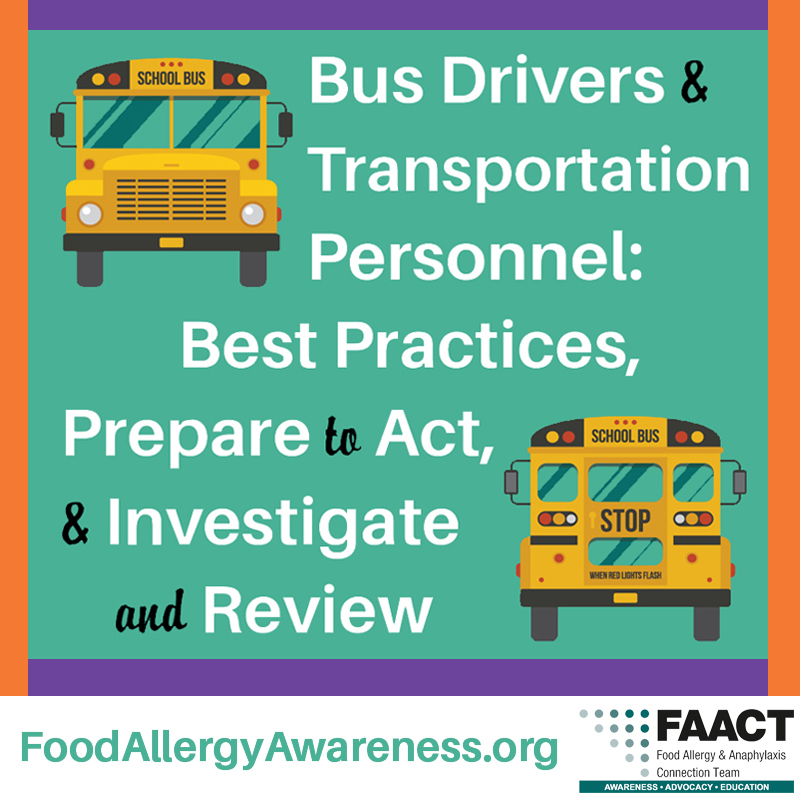
Best Practices for Bus Drivers and Transportation Personnel
Bus drivers and/or transportation department head should:
- Bus drivers and/or transportation department head should:Require participation of bus driver/transportation staff in staff food allergy and anaphylaxis training, including recognizing a reaction, administering epinephrine, etc.
- Encourage participation of bus driver/transportation staff in team planning meetings for food-allergic student(s). While it may not be practical for all transportation staff or bus drivers to attend all accommodation meetings, bus drivers and/or transportation staff will likely have responsibilities under a student’s 504 plan or other accommodation plan.
- Provide Allergy & Anaphylaxis Emergency Plans to bus drivers/transportation staff for each student with a life-threatening allergy. Review the plan each bus route.
- Require bus driver/transportation staff knowledge of location of epinephrine products and emergency medication for each student.
- Provide bus drivers/transportation staff with a list of students with food allergies, their allergens, and foods they cannot eat.
- Maintain a master list of student’s names and bus numbers.
- All students who have a life-threatening food allergy, riding the bus, should be identified by the school nurse and/or administrator.
- Create and maintain a plan for substitute bus drivers to be notified of a student with food allergies on their route.
- Create and maintain a plan for communicating with student’s emergency contact.
- Create and maintain a school system policy for students with food allergies.
- Ensure that bus drivers/transportation staff have a clear understanding of federal and state laws that protect the privacy and confidentialities of student information and other legal rights of students with food allergies.
- Create and maintain a policy for informing and training new substitute transportation staff or bus drivers of students with life-threatening food allergies.
- Enforce a “No Food or Beverages” policy on the bus.
- Do not provide food or candy to students.
- Follow the district’s cleaning practices, being sure to consider bus surfaces, seats, handrails.
- Consider and prioritize student placement on the bus (while limiting social isolation).
Prepare To Act
It is important that bus drivers and other transportation personnel prepare for and understand how to respond to a food allergy emergency.
Steps to take include:
- Ensure all bus drivers, bus attendants, and substitutes receive annual food allergy and anaphylaxis training.
- Learn how to recognize the signs and symptoms of an allergic reaction and anaphylaxis.
- Learn how to use all epinephrine products.
- Participate in semi-annual emergency drills.
- Act quickly; note student could be exposed prior to bus trip.
- Learn protocols and procedures for activating EMS.
- If an allergic reaction takes place, know the plan of action.
- Who is going to give epinephrine?
- Who is going to call 911 and by what method?
- Who is going to contact the parents? Where can these emergency numbers be located?
- Who is going to ride with the student to the hospital?
- Who is going to comfort and explain the situation to students on the bus and their parents
- Provide emergency communication device for each transport (cell phone, two-way radio, intercom, etc.), and require testing of the communication device prior to each transport.
- Does your route’s first responder carry epinephrine?
- Create and enforce policies that prohibit discrimination and bullying against all students, including those with food allergies.
- Create and maintain a bullying report procedure for students with life-threatening food allergies that allows the student to report bullying to school personnel and/or the Transportation Director.
- Create and maintain a policy for review after an emergency that includes the school administrators, school nurse, transportation staff, bus drivers, parents, EMS responders, staff members involved, the student, etc.
Investigate and Review
If an allergic reaction does take place on the school bus or while students are being transported in other ways, transportation personnel should:
- Attend the review meetings with parents, staff, and students.
- Review updates to the student’s Allergy & Anaphylaxis Emergency Plan and notify staff, aids, and substitute teachers.
- Confirm replacement of all emergency medications for the student(s).
Download FAACT's Bus Drivers and Transportation Personnel Best Practices/Prepare to Act Handout.
Download FAACT's Bus Drivers and Transportation Personnel Checklist.
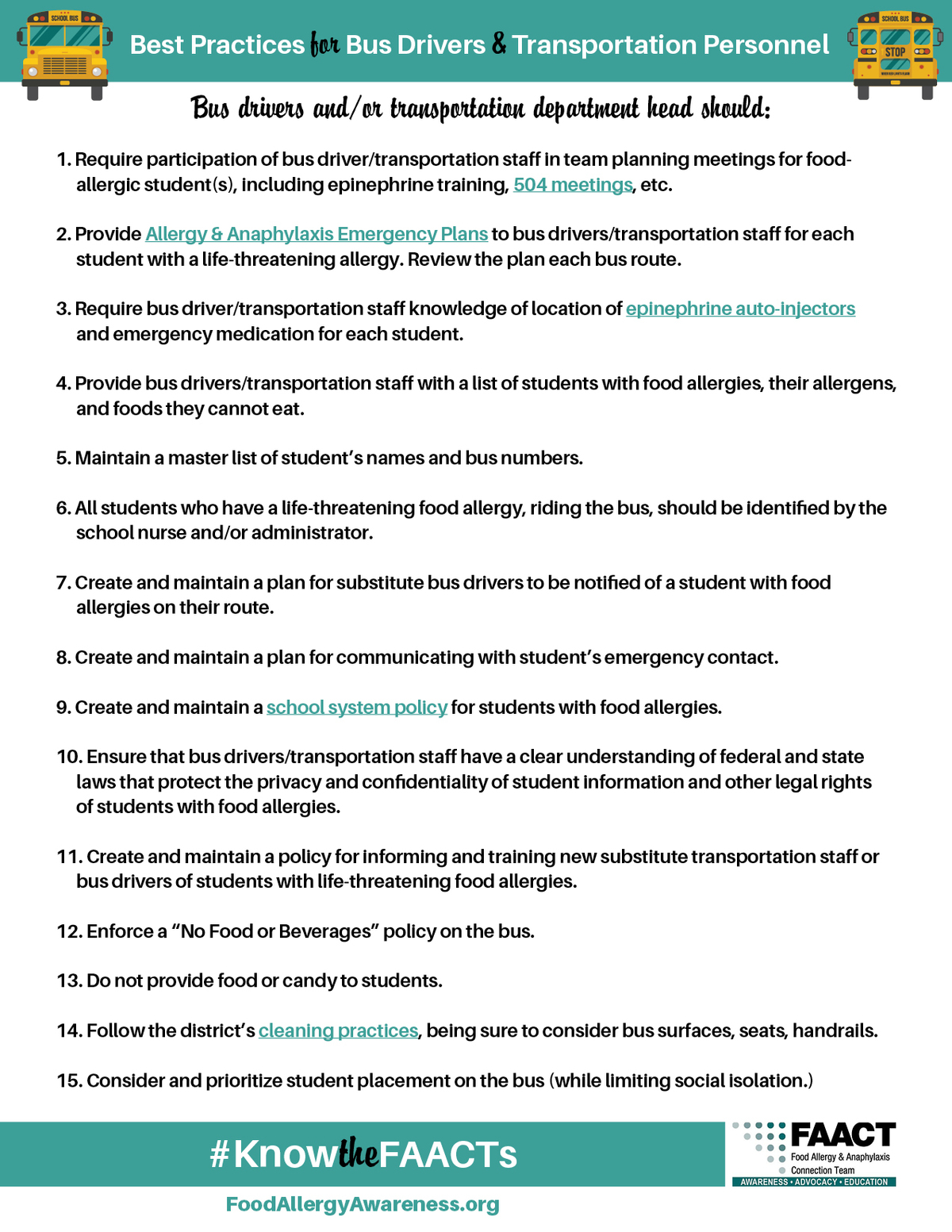
Resources and Downloads
- Allery & Anaphylaxis Emergency Plan (AAP)
- Cleaning Methods
- Signs and Symptoms of Anaphylaxis
- More About Epinephrine
- Food Allergy Management & Education (FAME) Toolkit
FAACT Posters
- 10 FAACTs to Know about Food Allergies
- Epinephrine Options Poster
- Food Allergy Education for School Personnel
- Food Allergy Safety - It's A Matter of FAACT!
- Field Trips - Best Practices
- Preventing Cross-Contact
- Traveling with Food Allergies
FAACTs
- Teenagers and young adults with food allergies are at the highest risk of fatal, food-induced anaphylaxis.
- 25% of first-time allergic reactions reported in the school setting were those of students with no-known history of an allergy.
What is Anaphylaxis?
Anaphylaxis (an–a–fi–LAK–sis) is a serious allergic reaction that often involves swelling, hives, lowered blood pressure, and, in severe cases, shock. If anaphylactic shock isn’t treated immediately, it can be fatal.
References
2 “Administration of Epinephrine for Life-Threatening Allergic Reactions in School Settings.”
C. Lynne McIntyre, RN, PhD, Anne H. Sheetz, RN, MPH, Constance R. Carroll, RN, MPH, Michael C. Young, MD.

